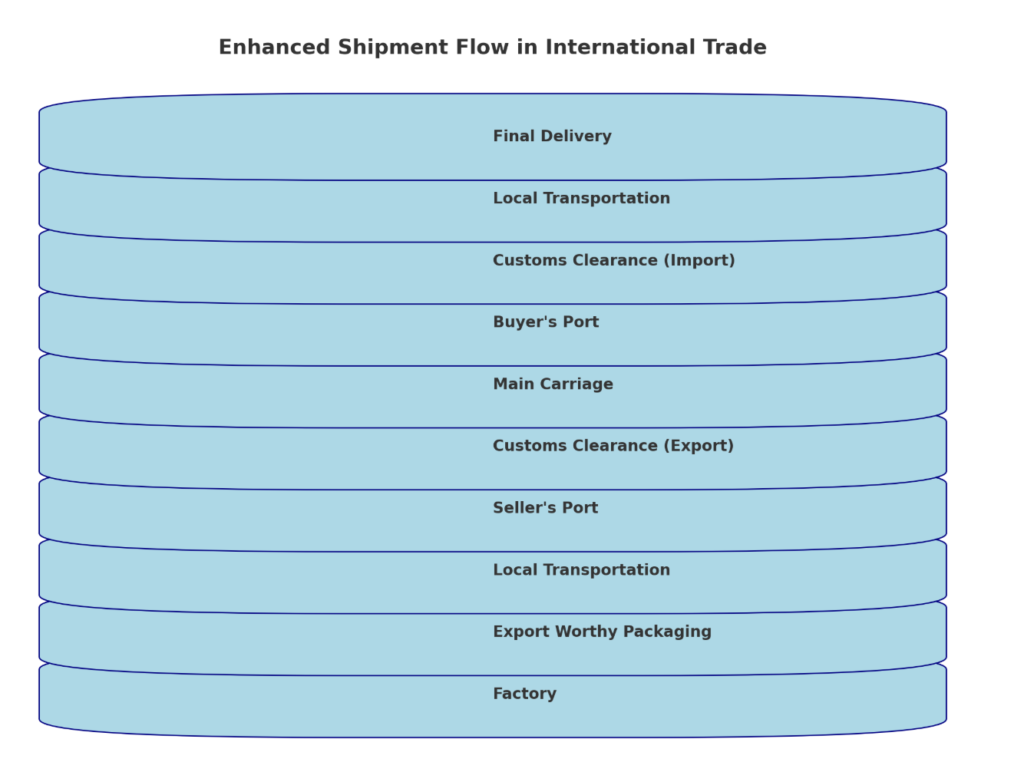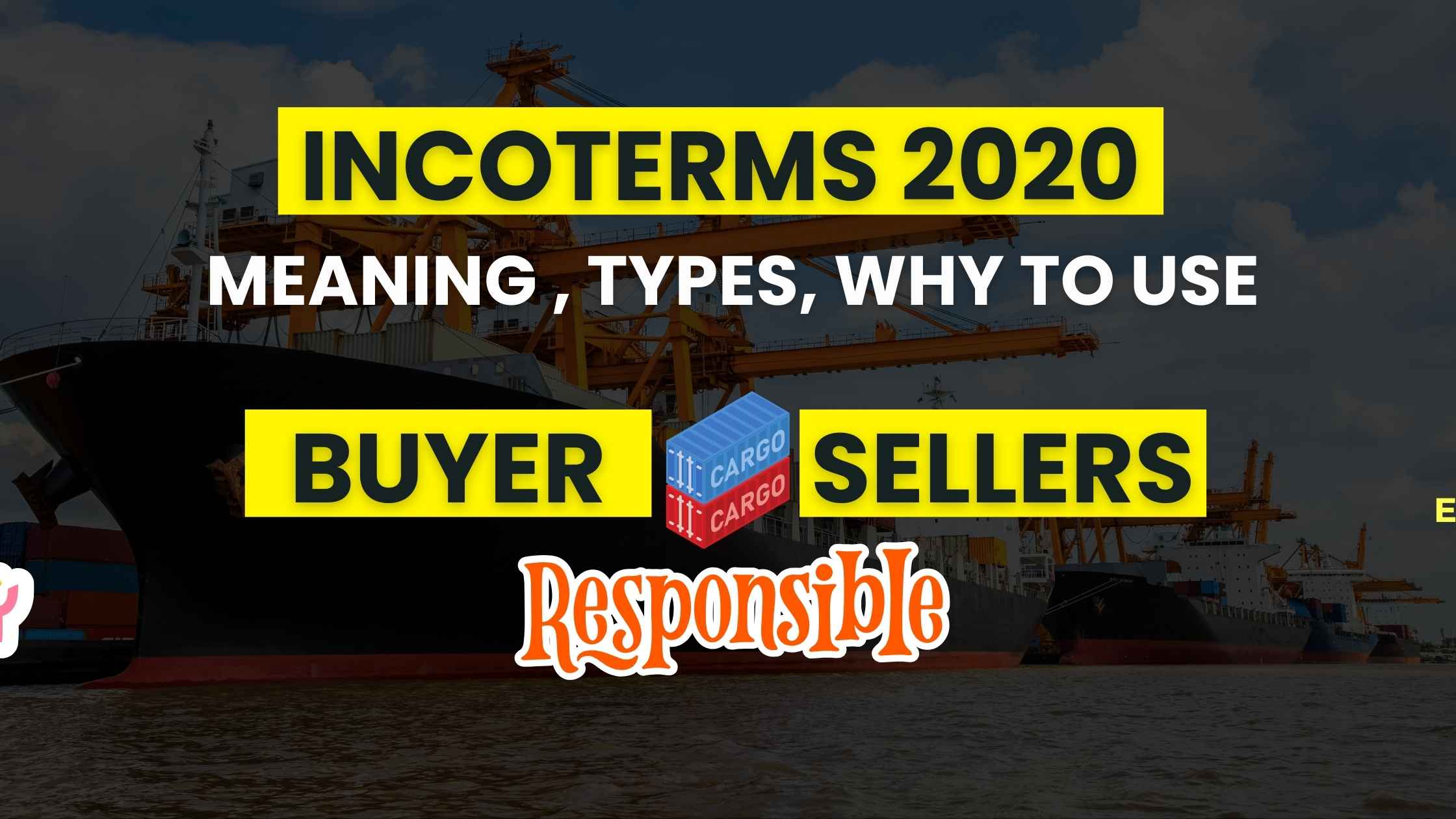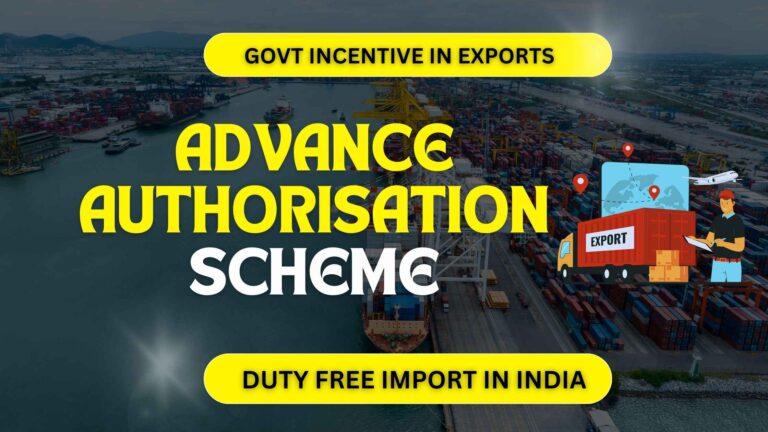Incoterms in International Trade: Meaning, Types, Pros and Cons, and Importance (Full Guide)
Incoterms, short for International Commercial Terms, are a set of globally recognized rules established by the International Chamber of Commerce (ICC). First introduced in 1936, these terms define the responsibilities of sellers and buyers in international trade transactions, specifying who is responsible for tasks such as shipping, insurance, documentation, and customs clearance.
What Are Incoterms?
Incoterms are standardized three-letter acronyms that delineate the obligations, costs, and risks associated with the transportation and delivery of goods in international trade. They provide a common framework, reducing misunderstandings and legal disputes between trading parties by clearly outlining each party’s duties.
Why Are Incoterms Important?
In the complex realm of international trade, clarity is paramount. Incoterms serve as a universal language, ensuring that buyers and sellers have a mutual understanding of their roles and responsibilities. This clarity helps in:
- Reducing Legal Risks: By standardizing terms, Incoterms minimize the potential for contractual disputes.
- Streamlining Negotiations: A common set of terms simplifies the negotiation process between international parties.
- Ensuring Compliance: They assist businesses in adhering to international trade regulations and practices.
How Does My Shipment Travel? (Shipment Flow in International Trade)

This chart illustrates each step from Factory to Final Delivery, with arrows clearly showing the flow direction. This makes it easier to understand the logistics journey, especially when explaining Incoterms.
- Factory – Where the goods are manufactured.
- Export Worthy Packaging – Packaging suitable for international shipping to ensure safety.
- Local Transportation – Transport from the factory to the port of export.
- Seller’s Port – The port where goods are loaded for international shipment.
- Customs Clearance (Export) – Completion of export documentation and customs formalities.
- Main Carriage – International transportation via sea, air, or land.
- Buyer’s Port – The destination port where goods are unloaded.
- Customs Clearance (Import) – Import duties, taxes, and documentation checks.
- Local Transportation – Delivery from the port to the buyer’s location.
- Final Delivery – Goods reach the buyer’s warehouse or destination.
Different Types of Incoterms
The latest version, Incoterms 2020, comprises 11 terms divided into 4 Major categories: Group E (Incoterms starting with E), Group F (Incoterms starting with F), Group C (Incoterms starting with C), Group D (Incoterms starting with D)

1. Group E – Departure Terms
- EXW (Ex Works)
- Example: A seller in Mumbai sells goods to a buyer in London. Under EXW, the buyer is responsible for picking up the goods from the seller’s factory and handling all costs and risks from that point onwards.
- Seller’s Responsibility: Only to make goods available at their premises.
- Buyer’s Responsibility: All transportation, insurance, export clearance, and import duties.
2. Group F – Main Carriage Unpaid
- FCA (Free Carrier)
- Example: A seller in Delhi delivers goods to the buyer’s nominated carrier at the port. The seller handles export clearance, but the buyer pays for the main transport.
- Seller’s Responsibility: Deliver goods to the carrier at a named place, complete export clearance.
- Buyer’s Responsibility: Main transport, insurance, and import duties.
- FAS (Free Alongside Ship)
- Example: Goods are delivered alongside a ship at the port in Mumbai. The buyer is responsible once the goods are alongside the ship.
- Seller’s Responsibility: Deliver goods alongside the ship and complete export customs formalities.
- Buyer’s Responsibility: Loading, main transport, insurance, and import customs.
- FOB (Free on Board)
- Example: The seller loads the goods onto a ship at Chennai port. The risk transfers to the buyer once the goods are on board.
- Seller’s Responsibility: Loading on the ship and export customs clearance.
- Buyer’s Responsibility: Main transport, insurance, and import duties.
3. Group C – Main Carriage Paid by Seller
- CFR (Cost and Freight)
- Example: The seller pays for transporting goods to the port in London but doesn’t cover insurance.
- Seller’s Responsibility: Freight cost to the destination port.
- Buyer’s Responsibility: Insurance and import duties. Risk passes once goods are on board.
- CIF (Cost, Insurance, and Freight)
- Example: The seller in Mumbai pays for transport and insurance to London.
- Seller’s Responsibility: Freight cost, insurance, and export customs.
- Buyer’s Responsibility: Import duties and risks once goods are on board.
- CPT (Carriage Paid To)
- Example: Goods are transported to the buyer’s city, but the seller doesn’t cover insurance.
- Seller’s Responsibility: Freight cost to the destination.
- Buyer’s Responsibility: Insurance and import duties. Risk passes to the buyer once the goods are handed to the first carrier.
- CIP (Carriage and Insurance Paid To)
- Example: The seller pays for transport and insurance to the buyer’s warehouse.
- Seller’s Responsibility: Freight cost and insurance to the destination.
- Buyer’s Responsibility: Import duties and risks after delivery to the first carrier.
4. Group D – Arrival Terms
- DAP (Delivered at Place)
- Example: The seller delivers goods to the buyer’s warehouse in New York.
- Seller’s Responsibility: Transport to the buyer’s location, excluding import duties.
- Buyer’s Responsibility: Import duties and unloading.
- DPU (Delivered at Place Unloaded)
- Example: Goods are delivered and unloaded at the buyer’s premises in Dubai.
- Seller’s Responsibility: Transport and unloading at the buyer’s location.
- Buyer’s Responsibility: Import duties.
- DDP (Delivered Duty Paid)
- Example: The seller delivers goods to the buyer’s location in Berlin, paying for all duties and taxes.
- Seller’s Responsibility: All costs, including transport, insurance, and import duties.
- Buyer’s Responsibility: Unloading at the final destination.
Note: 7 Incoterms are applicable for all modes of transportation, but 4 Incoterms (FOB, CIF, CFR, and FAS) are specifically applicable only for sea and inland waterway transport.
Choosing the Right Incoterm
- EXW and FCA are ideal for buyers who want control over the shipment.
- FOB, CFR, and CIF are suitable for sea shipments.
- DAP, DPU, and DDP are best when the seller wants to offer door-to-door delivery.
Let’s Take Example (By Keshav Dimri)
Let’s say an exporter in India sells goods to an importer in the USA. Using CIF (Cost, Insurance, and Freight):
- The Indian seller arranges and pays for the sea freight to the USA and insurance.
- The risk of damage or loss transfers to the USA buyer once goods are loaded on the ship in India.
- The USA buyer handles import duties and transportation from the port to their warehouse.
Pros and Cons of Incoterms
Incoterms provide clear guidelines on responsibilities and costs, reducing disputes in international trade. However, they can be complex to understand and may not cover all aspects of the shipping process.
Pros:
- Standardization: Provides a universally accepted set of terms, reducing confusion.
- Clarity: Clearly defines responsibilities, minimizing disputes.
- Efficiency: Streamlines contract negotiation and execution.
Cons:
- Complexity: Requires a thorough understanding to select the appropriate term.
- Limitations: Incoterms do not cover all aspects of a sale, such as payment terms or transfer of ownership.
- Misapplication: Incorrect usage can lead to misunderstandings and potential legal issues.
Note: Understanding and correctly applying Incoterms is vital for businesses engaged in international trade. They not only provide clarity and reduce risks but also facilitate smoother transactions across borders. By familiarizing themselves with these terms, exporters and importers can ensure that their trade practices are both efficient and compliant with global standards.
FAQ’s Related to Incoterms

What are Incoterms in international trade?
Incoterms are standardized trade terms used globally to define the roles and responsibilities of buyers and sellers in the delivery of goods, including who bears the costs, risks, and logistics.
How many Incoterms are there in Incoterms 2020?
There are 11 Incoterms in the latest version (Incoterms 2020), categorized into seven terms for any mode of transport and four terms exclusively for sea and inland waterway transport.
What is the difference between FOB and CIF?
Under FOB (Free on Board), the seller’s responsibility ends once the goods are loaded on the ship, while under CIF (Cost, Insurance, and Freight), the seller also arranges and pays for the insurance and freight to the destination port.
Which Incoterms are used for sea and inland waterway transport only?
FOB (Free on Board), CIF (Cost, Insurance, and Freight), CFR (Cost and Freight), and FAS (Free Alongside Ship) are specifically applicable for sea and inland waterway transport.
Who is responsible for insurance under Incoterms?
The seller is responsible for insurance under CIF and CIP terms, while for other Incoterms, the responsibility for insurance can be negotiated between the buyer and seller.
Can Incoterms be modified in a contract?
Yes, Incoterms can be customized as per the agreement between the buyer and seller, but any modifications should be clearly documented to avoid misunderstandings.
Do Incoterms cover the transfer of ownership?
No, Incoterms only define the transfer of risk and cost but do not specify the transfer of ownership of goods. Ownership is governed by the sales contract.
Are customs duties included in Incoterms?
Under DDP (Delivered Duty Paid), the seller is responsible for all customs duties and taxes at the destination. For other Incoterms, the buyer typically bears these costs.
Can Incoterms be used for domestic trade?
While Incoterms are primarily designed for international trade, they can also be used for domestic transactions to clearly define logistics responsibilities.
Why is it important to specify the version of Incoterms?
It is essential to specify the version (e.g., Incoterms 2020) because rules and responsibilities can change in different versions, affecting the interpretation of the contract terms.
If you want to learn import-export from basics to advanced, including company formation, import-export documents, product research in exports, finding foreign buyers, pre-shipment and post-shipment documentation, GST in exports, payment terms, Incoterms, and more, then watch this 7-hour video by Mr. Keshav Dimri, a successful exporter and brilliant marketer working since 2017.
If you found this guide helpful, you might also want to check out our other blogs on Advance Authorisation Scheme, Duty Drawback, and RODTEP Scheme to learn more about export incentives and cost-saving opportunities.






